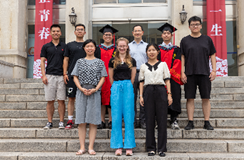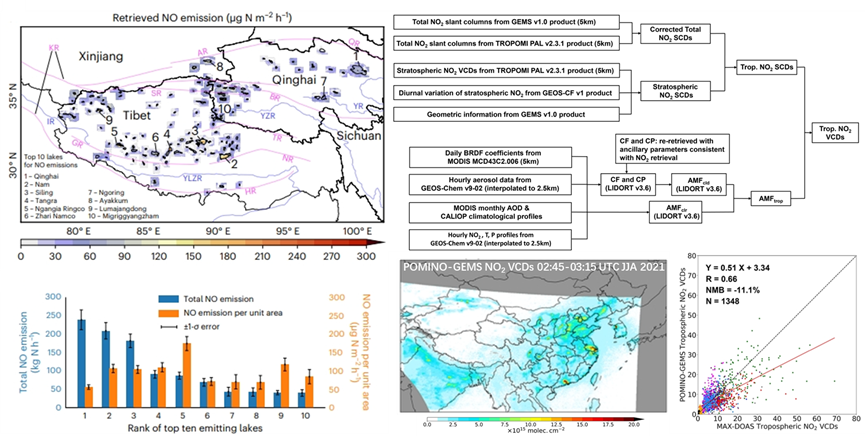全球化大气污染研究进展
Research Progress on Globalizing Air Pollution
http://www.pku-atmos-acm.org/


林金泰领导的ACM研究组主要围绕大气污染来源宏观和微观问题,构建全球化大气污染多学科研究思路和框架,从事大气化学、卫星遥感和气候变化方面的研究。本年度以第一作者或者通信作者发表SCI论文8篇,并发表合作论文10篇。主要成果如下:
1. 自主研发卫星遥感和排放反演算法并构建精细数据集,揭示我国氮氧化物污染时空分布特征和未知排放源。十余年来,研究组坚持自主研发基于卫星遥感的对流层二氧化氮垂直柱浓度以及氮氧化物排放反演算法,并构建数据集,为探索氮氧化物污染浓度和排放高分辨率时空变化特征和机制、服务精准减排提供关键方法和基础数据。本年度在这两个方面均取得重要成果:根据传统认识,远离人为活动的内陆水体的自然源NOx排放极少,并且在现有空气质量模型和气候模型中也未考虑。研究组基于自主开发的POMINO-TROPOMI卫星二氧化氮数据和PHLET排放反演算法,首次发现了青藏高原湖泊的高强度自然源NOx排放。所选取的135个湖泊排放总量与大型城市相当,平均单位面积排放强度超过我国农田平均排放(图1)。这些排放与青藏高原的气候变暖和生态变化等因素有关,表明可能存在前所未知的反馈机制。相关成果发表于Nature Geoscience,并被Nature遴选为亮点研究。此外,研究组基于全球首个主要探测痕量污染气体的地球同步卫星遥感探测器GEMS,改进自主研发的POMINO算法,开发POMINO-GEMS日间逐小时对流层二氧化氮垂直柱浓度数据集(图1)。我们自主设计了基于GEMS、TROPOMI数据和GEOS-CF模型的融合算法,计算获得了2020年12月以来的二氧化氮数据,这些数
据和现有极轨卫星数据的时空相关性强且平均偏差小,并且与地基和车载MAX-DOAS观测及MEE地基浓度观
测在日内变化方面呈现出良好的一致性。POMINO-GEMS数据已向学术界免费公开。(Kong, Lin* et al., Nature Geoscience, 2023; Zhang, Lin* et al., AMT, 2023)
2. 揭示全球化污染背景下大气输送和社会经济变化对PM2.5的影响。研究组长期致力于融合多学科研究方法,探索大气输送、贸易活动及其协同作用所引起的全球化大气污染及其影响和应对问题。由于PM2.5在大气中的生命周期较短,一般认为境外的人为排放通过大气输送对我国近地面PM2.5污染所造成的影响较少。然而,事实是否如此并不清楚。为此,研究组定量评估了境外大气污染物的跨境输送对我国近地面PM2.5总量及不同组分的贡献,发现2015年全年华北和华东地区大气中8%的PM2.5(5 μg m-3)和其中19%的硝酸盐由境外人为排放所造成,并且境外输送的贡献在1月份更为显著。其原因是,境外污染物可以通过大气输送与我国境内排放的污染物产生化学反应,增强我国东部地区的大气氧化性和硝酸铵颗粒物生成,从而加剧我国境内PM2.5污染,该效应占境外污染对我国总体影响的70%(其余30%为直接输送影响)。相关成果被作为“亮点论文”发表于Atmospheric Chemistry and Physics。在此基础上,我们定量评估了境外污染输送对我国未来空气质量目标的影响,发现我国和其他国家共同选择低碳路径可减少我国所承受跨境污染的63%和约38.6万过早死亡,指出了跨境污染对未来空气质量预期和污染治理目标实现的重要性(图2)。此外,研究组采用交叉学科方法,探索了中国城市化进程导致的空气污染健康影响,量化了中国城市和农村居民直接、间接消费所隐含的PM2.5污染及其健康效应,以及由此导致的人群间不平等性;探索了与新冠疫情类似的长期流行病对全球经济、居民收入及其相应的排放、空气污染暴露和人群健康的影响,揭示了收入影响下的居民部门排放变化是PM2.5污染健康效应的地区间不平等性的关键因素(图2)。(Xu, Lin* et al., ACP, 2023a,b; Wang, Lin*, et al., Science Bulletin, in press; Li, Lin* et al., STE, 2023)
The Atmospheric Chemistry & Modeling (ACM) group led by Jintai Lin focuses on assessing the sources of air pollution and greenhouse gases from microscopic and macroscopic views, with its research areas covering atmospheric chemistry, satellite remote sensing and climate change. A particular passion of ACM is establishing a multi-disciplinary framework to address the grand problem of globalizing air pollution caused by atmospheric transport, economic trade and their synergistic effects. In this year, a total of 8 papers with Jintai Lin as first and/or corresponding author, together with his 10 co-authored papers, have been published. Selected works include:
1. Developed retrieval algorithms and data products for tropospheric NO2 columns and NOx emissions at high resolutions based on satellite remote sensing, and uncovered previously unknown emission sources. For more than a decade, the ACM group has been devoted to the retrieval of tropospheric NO2 vertical column densities (VCDs) and subsequent NOx emissions at high resolutions based on satellite remote sensing. In this year, based on our POMINO-TROPOMI NO2 VCD data and PHLET inversion algorithm for NOx emissions, we discovered previously unknown high NOx emissions from natural lakes away from human activities on the Tibetan Plateau (Fig. 1). Our finding challenges the conventional wisdom suggesting insignificant emissions from natural inland waters. The total emissions from the 135 selected large lakes are comparable to those from individual megacities, with the average per-unit-area emission intensity surpassing that of cropland average in China. These emissions are influenced by climate warming and ecological changes, suggesting previously unknown feedback mechanisms. The finding was published in Nature Geoscience and marked as Research Highlight by Nature. (Kong, Lin* et al., Nature Geoscience, 2023)
Additionally, we modified and applied our POMINO NO2 algorithm to GEMS, the first geostationary satellite instrument to detect tropospheric NO2 and other gaseous pollutants. Through a fusion algorithm combining GEMS, TROPOMI, and the GEOS-CF data, we developed the POMINO-GEMS algorithm and data product for daytime hourly tropospheric NO2 VCDs since December 2020 (Fig. 1). POMINO-GEMS NO2 data are consistent with those from sun-synchronous satellite instruments, ground-based and vehicle-mounted MAX-DOAS observations, as well as MEE ground-based concentration measurements. POMINO-GEMS data are freely available. (Zhang, Lin* et al., AMT, 2023)
2. Revealed the impacts of atmospheric transport and socioeconomic changes on PM2.5 pollution. For years, the ACM group has been leading the studies of globalizing air pollution and its impacts on air quality, human health and climate through interdisciplinary methods. Several important results were found this year, as follows.
Given the short lifetime of PM2.5, the transboundary impact of foreign anthropogenic emissions on China’s air quality through atmospheric transport has typically been simplified or neglected. However, we found that 8% of near-surface PM2.5 (5 μg m-3) and 19% of nitrate over North China and East China in 2015 were caused by foreign anthropogenic emissions. This is because foreign transported pollution interacts chemically with China’s locally emitted pollutants to cause stronger formation of ammonium nitrate. Such a chemical mechanism accounts for about 70% of the overall influence of foreign anthropogenic emissions on PM2.5 over North China and East China. The associated article was published in Atmospheric Chemistry and Physics as Highlight Paper. Based on this result, we further quantified the impacts of foreign pollution on China's future air quality and health improvements. We found that adopting the low-carbon instead of the fossil-fuel-intensive pathway in both China and foreign countries would reduce 63% of transboundary pollution and prevent approximately 386,000 associated premature deaths in China. This finding underscores the importance of transboundary pollution for establishing future air quality expectations and pollution mitigation strategies (Fig. 2). (Xu, Lin* et al., ACP, 2023a,b)
Based on an interdisciplinary approach, we further assessed the health impacts of PM2.5 exposure along with China's urbanization process. We explored the PM2.5 pollution contributed directly or indirectly by urban and rural household consumption activities, and revealed the underlying urban-rural inequalities to be avoided/alleviated during the nation’s further urbanization process. Finally, we investigated the long-term effects of COVID-like pandemics on ambient PM2.5 and resulting premature mortality worldwide, by comprehensively considering the changes in transportation, economic production and household energy use. We found that changes in household income play an important role in inter-regional health inequality associated with pandemic-caused PM2.5 pollution change, through altering household fuel types in less developed regions (Fig. 2). Together, these studies offer valuable insight into human impacts on the environment and resulting influence on public health. (Wang, Lin*, et al., Science Bulletin, in press; Li, Lin* et al., STE, 2023)

图1. 基于自主研发的PHLET排放反演算法和POMINO-TROPOMI卫星NO2柱浓度数据反演得到的2019年夏季青藏高原湖泊自然源NOx排放(左上);反演结果中NOx排放总量最高的10个湖泊的排放总量及单位面积排放强度(左下);自主开发的POMINO-GEMS日内逐小时NO2柱浓度融合反演算法(右上);2021年夏季POMINO-GEMS数据结果及其与地基MAX-DOAS观测的对比(右下)。来源:Kong, Lin* et al., Nature Geoscience, 2023; Zhang, Lin* et al., AMT, 2023。
Figure 1. Retrieved NOx emissions in JJA 2019 from 135 Tibetan Plateau lakes based on our PHLET emission inversion algorithm and POMINO-TROPOMI NO2 VCD data (upper left); NOx emission totals and per-unit-area emission intensities from the top 10 emitting lakes (lower left); Flow chart of the POMINO-GEMS retrieval algorithm (upper right); POMINO-GEMS NO2 VCDs around 03:00 UTC in JJA 2021 and comparison with ground-based MAX-DOAS observations (lower right). Source: Kong, Lin* et al., Nature Geoscience, 2023; Zhang, Lin* et al., AMT, 2023.

图2. 2015年全年境外污染物的跨境输送对我国PM2.5总量和硝酸盐的贡献(左上);未来不同政策路径下中国达到空气质量目标的城市占比(左下);类新冠长期流行病对不同国家和地区所造成的经济和污染效应对比(右上);2015年城市和乡村居民的直接和间接消费所引起的PM2.5相关过早死亡数量及其所承受的健康影响的对比(右下)。来源:Xu, Lin* et al., ACP, 2023a, b; Wang, Lin*, et al., Science Bulletin, in press; Li, Lin* et al., STE, 2023。
Figure 2. Annual mean contributions of foreign anthropogenic emissions to China’s total and compositional PM2.5 concentrations in 2015 (upper left); Percent of cities achieving future air quality goals in China under current-policy and carbon-neutral scenarios (lower left); PM2.5-related premature deaths in China in 2015 caused by urban and rural household consumption and exerting upon these households (upper right); Contrast between economic and pollution changes caused by a COVID-19 like long-term pandemic (lower right). Source: Xu, Lin* et al., ACP, 2023a,b; Wang, Lin*, et al., Science Bulletin, in press; Li, Lin* et al., STE, 2023.
References:
(* Corresponding Author; # Joint first author; Group Member)
Kong, H., Lin, J.-T.*, Zhang, Y.-H., Li, C.-J., Xu, C.-H., Shen, L., Liu, X.J., Yang, K., Su, H., and Xu, W.-Y.: High natural nitric oxide emissions from lakes on Tibetan Plateau under rapid warming, Nature Geoscience, 16, 474–477, doi:10.1038/s41561-023-01200-8, 2023
Li, C.-J., Lin, J.-T.*, Chen, L.-L., Cui Q., Liu Y., McDuffie, E. E., Du, M.-X., Kong, H., and Wang, J.-X.: Inter-regional environmental imbalance under lasting pandemic exacerbated by residential response, Science of The Total Environment, 879, 163191, doi:10.1016/j.scitotenv.2023.163191, 2023
Wang, J.-X., Lin, J.-T.*, Liu, Y., Wu, F., Ni, R.-J., Chen, L.-L., Ren, F.-X., Du, M.-X., Li, Z.-Y., Zhang, H.-Y., and Liu, Z.-Z.: Direct and indirect consumption activities drive distinct urban-rural inequalities in air pollution-related mortality in China, Science Bulletin, in press, doi:10.1016/j.scib.2023.12.023, 2023
Xu, J.-W., Lin, J.-T.*, Luo, G., Adeniran, J., and Kong, H.: Foreign emissions exacerbate PM2.5 pollution in China through nitrate chemistry, Atmospheric Chemistry and Physics, 23, 7, 4149–4163, doi:10.5194/acp-23-4149-2023, 2023a
Xu, J.-W., Lin, J.-T.*, Tong, D., and Chen, L.-L.: The underappreciated role of transboundary pollution in future air quality and health improvements in China, Atmospheric Chemistry and Physics, 23, 17, 10075–10089, doi:10.5194/acp-23-10075-2023, 2023b
Zhang, Y.-H., Lin, J.-T.*, Kim, J., Lee, H., Park, J., Hong, H., Van Roozendael, M., Hendrick, F., Wang, T., Wang, P.-C., He, Q., Qin, K., Choi, Y., Kanaya, Y., Xu, J., Xie, P.-H., Tian, X., Zhang, S.-B., Wang, S.-S., Cheng, S.-Y., Cheng, X.-H., Ma, J.-Z., Wagner, T., Spurr, R., Chen, L.-L., Kong, H., and Liu, M.-Y.: A research product for tropospheric NO2 columns from Geostationary Environment Monitoring Spectrometer based on Peking University OMI NO2 algorithm, Atmospheric Measurement Techniques, 16, 19, 4643–4665, doi:10.5194/amt-16-4643-2023, 2023
